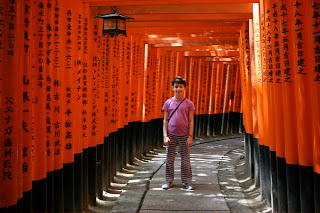
¿Por qué hay mil uno budas en el templo Sanjusangen-do? ¿Y por qué hay más de mil portillos en el templo shitoísta Fushimi-Inari Taisha? Cada uno tiene su historia. El templo Sanjusangen-do está aquí porque un emperador construyó mil uno budas por que tenía muchos dolores de cabeza. Creía que los budas pararían sus dolores de cabeza, y lo más budas lo menos dolores de cabeza. El templo shintoísta Fushimi-Inari Taisha es un templo para hacer crecer arroz y suerte para los granjeros. Tiene miles de portillos porque cualquier persona puede comprar un portillo para poner en el templo. Ahora, la mayoría de las personas no son granjeros, entonces personas compran unLo m portillo para tener suerte en su trabajo. Lo más portillos, lo más suerte en los trabajos.



























